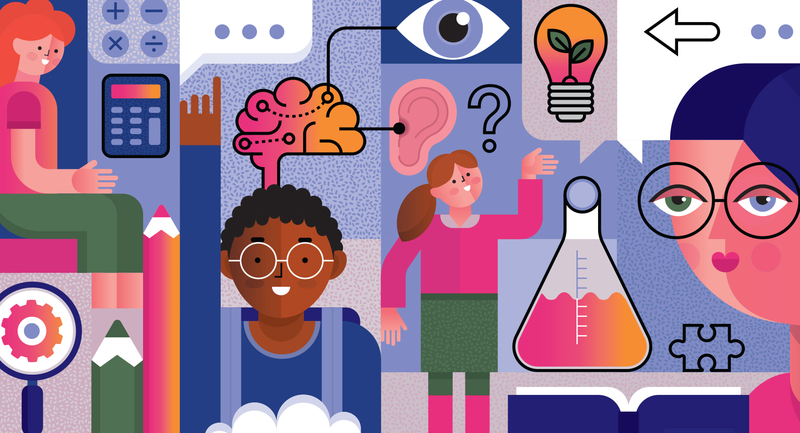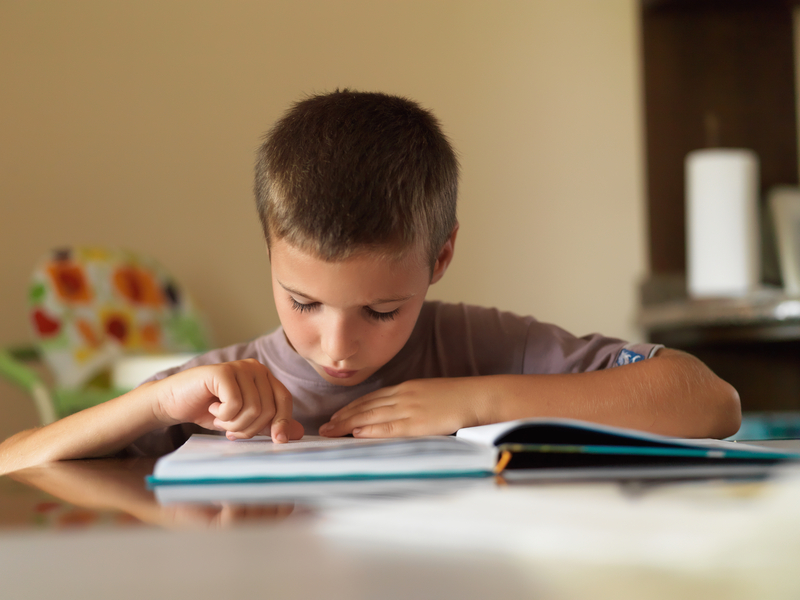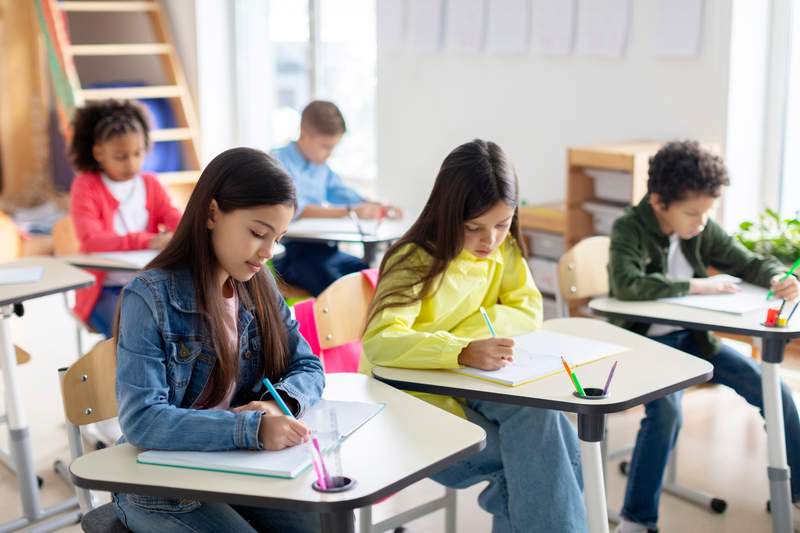At Washington Elementary School, Mary Beth, a 7-year-old facing significant cognitive and behavioral challenges, is now fully included in the regular 2nd grade classroom. Teachers have received training and support for adapting the curriculum so that Mary Beth and other students who were previously segregated in special education classrooms and schools have returned to their home school.
Washington Elementary has invested considerable effort in creating a learning community that embraces all kinds of differences, and teachers and parents are excited about the new inclusive education program. To support a highly interactive, multilevel, multimodality curriculum, the school is using cooperative learning, whole language, and authentic assessment. Programs that promote peer tutoring and peer advocacy are also in place.
At nearby Jefferson Elementary School, 8-year-old Jason is pulled out one day a week to attend the district's gifted program in a school across town. Often bored and unchallenged, Jason had been labeled a “nerd” and an “egghead.” The gifted program is highly participatory, community-based, and project-centered, and encourages creative expression as well as cognitive development. Jason is pleased to be making friends in the gifted program, where he has met other students “like him.”
Across the country, both of these scenarios are being played out, sometimes within the same school or district. Are these compatible directions in education? Can schools move toward integration in one area and toward segregation in another within a shared vision of education?
What Is an Inclusive School?
Many advocates of gifted education are apprehensive about the move toward full inclusion. They fear that detracking will result in the dissolution of quality, the abandonment of differentiated programs for accelerated students, the dumbing-down of curriculums, and the denial of individual differences. One of the major strategies promoted by inclusion proponents—cooperative learning—has come under particular fire. Some warn that such an emphasis will deny gifted students appropriate challenges, placing them forever in the roles of tutoring less-advanced students (Matthews 1992). Proponents of detracking, on the other hand, challenge the notion that the schools are currently working well for the majority of students, arguing for systemic, structural reform that addresses more fundamental questions of curriculum and pedagogy (George 1992, Oakes 1985).
The following definition provides an initial answer to the compatibility of inclusive schools and segregated gifted programs. Stainback and Stainback (1990) define an inclusive school as one that educates all students in the mainstream ... providing [them with] appropriate educational programs that are challenging yet geared to their capabilities and needs as well as any support and assistance they and/or their teachers may need to be successful in the mainstream. But an inclusive school also goes beyond this. An inclusive school is a place where everyone belongs, is accepted, supports, and is supported by his or her peers and other members of the school community in the course of having his or her educational needs met (p. 3).
The message that “if you're different, then you have to leave” may seriously challenge children's sense of a secure place in the classroom.
Removing children who are publicly identified as different makes it more difficult to promote multicultural education and a positive response to differences.
Cohesive communities require open communication about differences. Not discussing differences openly—for example, why only some children have been selected for the gifted program—can create a climate of distrust and alienation (Sapon-Shevin 1994).
Children's coming and going from gifted classes can disrupt the classroom flow and make it difficult for teachers to establish a cohesive group.
Taking children away from the regular classroom to meet their special needs challenges teachers' sense of themselves as responsible for or capable of teaching toward diversity (Sapon-Shevin 1994).
It is important to emphasize that moving toward and embracing inclusion is a process and not a singular act (Stainback and Stainback 1990). Districts that say “We did inclusion last year” will likely be districts that also say “We tried inclusion, and it didn't work!” The reality is that inclusion involves changes in philosophy, curriculum, teaching strategy, and structural organization. Changes such as these go far beyond affecting only those students labeled as “handicapped” and far beyond the purview of what has traditionally been considered special education. Each of these changes has the capacity to effect the kinds of changes and support needed by gifted students as well.
Classrooms that Embrace Diversity
First, inclusion means establishing and maintaining warm, accepting classroom communities that embrace diversity and honor differences. Teachers concerned with creating classrooms in which all students are fully included tend to emphasize the social atmosphere of the classroom and take active steps to teach and model respect for differences. The same students who learn that “Tarisa uses a communication board because she isn't able to speak” can quickly learn that students read books at different levels on the same topic, or that Noah doesn't eat hot dogs or celebrate Christmas but that he knows a lot about tofu and Chanukah.
Open discussions about prejudice, stereotypes, and exclusion have the potential to alter the classroom atmosphere for all students. The same principles apply: we don't judge people by their appearance, we look for commonalities, and so on. One teacher, for example, drew a grid on her wall with her students' names listed on both axes and then asked the students to find something they had in common with every other student in the class.
A frequent reason that gifted students are removed from typical classrooms is that they need a more supportive environment. Gifted students often report isolation and lack of acceptance in typical heterogeneous classrooms (Deslisle 1984). Gifted students, like all students, need to be in classrooms in which their skills and talents are appreciated and their struggles and challenges are supported.
But why should we assume that this kind of classroom atmosphere is best achieved (or only achieved) by segregating gifted students? Inclusion and respect for diversity are not principles limited to students with disabilities or students with “gifts”; differences in race, religion, ethnicity, family background, economic level, and ability are present in all classrooms. For example, Kari should not have to hide the fact that she has two mothers, or Larissa the fact that she celebrates Kwanzaa. In inclusive classrooms, with effective instruction and strong support, students can become knowledgeable and supportive of other students in all of these dimensions.
A Broader Curriculum
Second, inclusion means implementing a multilevel, multimodality curriculum. Teaching a purposefully heterogeneous classroom involves deep changes in the nature of the curriculum (Stainback and Stainback 1990). Teachers in inclusive classrooms are consistently moving away from rigid, textbook- and basal-driven frontal teaching toward cooperative learning, whole language, thematic instruction, critical thinking, problem solving, and authentic assessment.
For example, a group of teachers sit down to plan a 4th grade unit on Texas. Using the map of Texas as a starting point, they brainstorm objectives in reading, writing, spelling, creative problem solving, science, social studies, art, music, drama, and math. Their ideas include role-playing, cooperative group investigations of various topics, building dioramas and creating murals, writing songs and dances, field trips and hands-on activities, writing letters to state officials to investigate pending legislation, planning a trip across the state calculating mileage and expenses, and so on. These activities are multimodality, child-centered, interactive, participatory, and fun. Not only do they cross traditional disciplines, but they also include academic and cognitive challenges at many levels.
Within a broadly designed curriculum such as this, including students with varying educational needs becomes much easier. Nicole, who has cerebral palsy and is working on her fine motor skills, is busy cutting and pasting state landmarks on a wall chart of Texas. She is working with José, newly arrived from Mexico, who is also teaching the whole class the Spanish words for city, town, river, and so on. A small group of students is preparing a role-play on the establishment of the state of Texas, exploring past and current tensions regarding borders, language, and racial issues. Tammy, who is identified as gifted, is preparing a newsletter on the project. While working on her own research and writing skills, she is interviewing classmates and learning to listen well to others and to paraphrase and transcribe conversations.
Advocates for gifted education often cite the boring, rigid regular classroom curriculum as justification for the removal of gifted students. They state the gifted students need a maximum level of achievement in basic skills and concepts, learning activities at an appropriate level and pace, experience in creative thinking and problem solving, convergent thinking skills, self-awareness, exposure to a variety of fields, and the development of independence, self-direction and discipline in learning (Feldhusen and Wyman 1980, pp. 15–21). No items on the above list are objectionable, except that they are recommended for gifted students rather than for all students. Many of the strategies of gifted education—curriculum compacting, independent study, mentorships and thematic instruction—can and should be a part of all classrooms.
Interactive Teaching and Learning
Third, inclusion means preparing and supporting teachers to teach interactively. Changes in the curriculum are closely linked to changes in pedagogy. The classroom model of one teacher trying to meet the needs of an entire class of children single-handedly is being replaced by structures in which students work together, teach one another, and actively participate in their own and their classmates' education. The relationship between inclusive classrooms and cooperative learning has become quite clear (Sapon-Shevin 1990, Sapon-Shevin et al. 1994); we want students included in classrooms not to compete with others, but to learn with and from others.
The model becomes not “I'm the teacher and I don't want to see any learning going on unless I'm in charge” but “I am one teacher here. My task is to facilitate your learning, and there are 30 other sources of knowledge, support, and teaching.” Multiple intelligences are also acknowledged and supported so that the same children are not consistently the “helpers” and others the “helpees.”
Educators of the gifted often describe the anguish of children who continually have to wait for others to catch up, who are embarrassed by their own advanced achievement, or whose particular talents are not valued within the typical classroom. But it is a mistake to think of these problems as problems of gifted students. No children should have to put up with inflexibility, boring curriculums, lack of creativity, excessive regimentation, over-standardization, and limited conceptions of teaching and learning. Improvement in these areas within a context of coherent, structural reform, will result not only in greater acceptance and learning for gifted students but for all students.
Support for Teachers
Fourth, inclusion means providing ongoing support for teachers in their classrooms and breaking down the barriers of professional isolation. Although teachers are surrounded by people, teaching can be an incredibly isolating job. Hallmarks of inclusion include team teaching, collaboration and consultation, and other ways of accessing the skills, knowledge, and support of the many individuals charged with educating a group of children.
Many inclusion models make extensive use of teaming and cooperation among teachers, paraprofessionals, speech and language therapists, physical and occupational therapists, counselors, and so on. Although learning to work successfully with other adults often requires training, support, and ongoing assessment, the synergistic nature of adult collaboration is exciting! When a language specialist becomes a member of the 4th grade team, he or she is able to make suggestions not only about how to improve Mark's speech, but also how to incorporate language-rich activities into all aspects of the school day.
Often, teachers can assume increasing responsibility for what had been specialized, pull-out services when they receive opportunities and support for integrating such activities into their classrooms. Many teachers report that the modifications and adjustments that they have made for a specific student have had a positive impact on a wider group of students; for example, putting the key vocabulary words up on the board before the lesson helps not only the student with learning difficulties, but other students as well. The exemplary teaching that occurs in many inclusive classrooms is often a function of the shared expertise and collaboration of several people, each freely and openly sharing his or her skills and specialties.
How would gifted students benefit from increased adult interaction and collaboration? Relying on one teacher to meet the educational needs of a gifted student makes no more sense than relying on the regular teacher to meet the needs of a student with disabilities without any form of consultation. In models where the teacher of the gifted consults with the regular classroom teacher on how to enrich classroom activities, not only is the fragmentation of pull-out programs eliminated, but the education of all children is enriched.
When I was writing Playing Favorites: Gifted Education and the Disruption of Community (Sapon-Shevin 1994), many of the teachers reported that they were relieved that someone else was meeting the gifted students' needs (thus eliminating the need for them to modify curriculum or teaching). Others were resentful of the kinds of support provided to the gifted teacher (smaller class size and extra materials, for example) and felt that students didn't need to leave their rooms to get a good education. Either way, the exciting curriculum provided in the gifted program was not integrated with other learning and was limited to a very few students. When teachers work together, however, they can share their knowledge and skills and create multilevel classroom units and projects that are challenging for all students.
Parent Involvement
Finally, inclusion means involving parents in the planning process in meaningful ways. Inclusive education programs have relied heavily on the input of parents into their child's education. For example, parental involvement in Individualized Educational Program meetings is mandated by law. Many gifted education programs have also benefited from high levels of parental participation (sometimes required for a child's acceptance in the program). Unfortunately, however, parents of students with disabilities and parents of students identified as gifted have often been positioned against one another to fight over the same small pot of funds.
Many teachers I interviewed said that it was about time we spent money on gifted students, since we've already spent too much on students with disabilities. Parental advocacy often takes the form of separate parent organizations: the regular PTO, open to all parents; the Parents of the Handicapped Organization; and the Parents of the Gifted and Talented Organization. Each group lobbies for better educational programming, seeks to educate the broader community about its needs, and attempts to secure the best education possible for its children. But this kind of splintering often results in tension, limited effectiveness, and the inability to bring about systemic, whole-school change. At its worst, racial divisions and prejudice become even further ingrained.
Comprehensive school reform entails two components. The first is a firm vision of the way schools could or should be. The ability to imagine schools otherwise—not stratified by ability, not beholden to a fixed curriculum, well staffed with innovative, engaging teachers who are themselves well supported—is the first requirement. But the second essential component of wide-ranging school reform, as opposed to program innovation or school tinkering, is a shared agenda: the understanding that fixing the school for some children must mean fixing the school for all children.
Meeting the Needs of All Students
Advocates of full inclusion and those who struggle for appropriate education for students identified as gifted must not become entrenched enemies. There is little that is incompatible in the vision of both groups: schools that teach, challenge, and honor children for who they are. If we must settle for classrooms as they are now organized and staffed, curriculum as it is currently defined, and teaching strategies limited to lecture and whole-group instruction, then it is no wonder that advocates for gifted students see the students' removal and segregation as the only viable solution.
If, however, we can envision new models of school organization, curriculum, and pedagogy, then we can embrace within that vision classrooms that meet the needs of all students, including those identified as gifted. If we can see our goal as not just saving those students for whom educational —ality or failure is considered intolerable, but as assuring educational success for all children, then there are other possibilities. And, if we can look at aspects of the current system that are not working for students labeled as gifted as barometers of an unsuccessful system rather than as justification for removing students to a better subsystem, then we can work together toward far-reaching, comprehensive school reform for all students.







